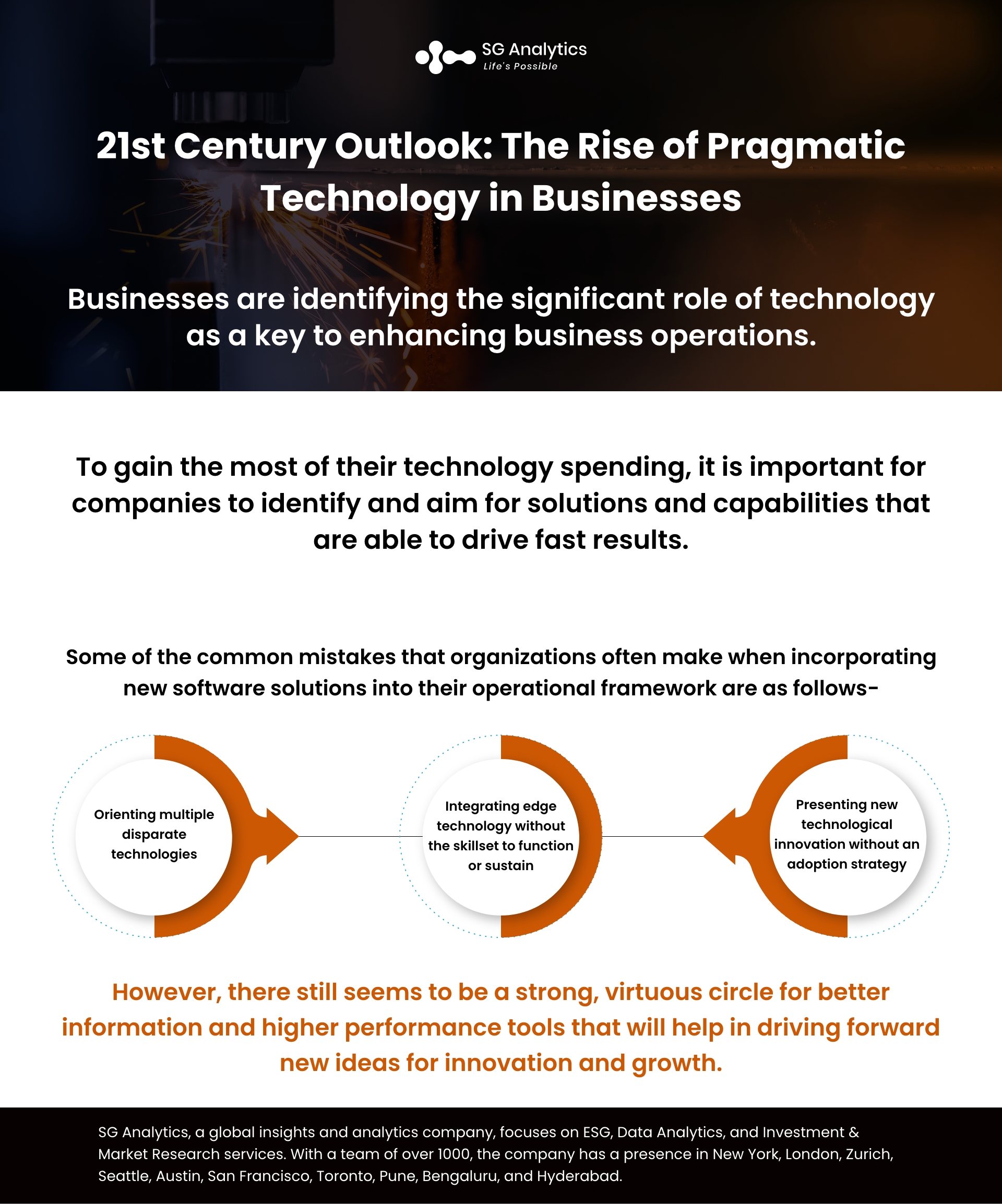In today's age of digital acceleration and transformation, businesses are identifying the significant role of technology as a key in enhancing business operations. Software solutions are being employed more than ever, ranging from business intelligence (BI) to customer relationship management (CRM), enterprise resource planning (ERP), and data management platforms. A recent Statista report highlighted that the revenue in this sector is set to grow by $118.5 billion by the end of the year 2022.
While the technology market is booming, and for a good reason, many organizations are choosing to invest in tech without understanding how it will assist them in driving fruitful business outcomes. Many organizations are making the common mistake of selecting platforms due to their popularity and buzzwords. AI and machine learning, data mesh, blockchain, and data marketplaces are everywhere today, and this, paired with a lack of understanding of the new technologies, is getting in the way of executives looking to make smart technology investments.

To gain the most significant outcome from their technology spending, it is important for companies to identify and aim for solutions and capabilities that can drive fast results. They should focus on investing their resources in pragmatic and valuable technologies that present the most reliable solution as well as serve their needs. By designing an adoption framework that focuses on enhancing business processes along with increasing ROI, businesses can find solutions rather than just creating hype and empty promises for what works in a global solution.
Read more: Tech-Related Ethical Concerns Businesses Should Address in 2022
Technologies like artificial intelligence and machine learning require complex algorithms and massive amounts of data. This adds to existing challenges within an organization, including data privacy, data security, and knowledge gaps. To make their operations sustainable, businesses need to undertake the simplest and most established solution to decipher a problem instead of taking risks.
Some of the common mistakes that organizations often make when incorporating new software solutions into their operational framework are as follows. However, it is equally important for them to identify ways to avoid them.
-
Orienting multiple disparate technologies
Many organizations often make a critical mistake by mandating their employees to operate on multiple platforms in their everyday tasks. This leads to context switching, i.e., the human tendency to transition back and forth between unrelated tasks. Research has highlighted that context switching leads to a decrease in the productivity of the employees and increases their frustration.

While there is productivity loss due to context switching, integration of multiple platforms can also lead to data silos that will not only slow down the productivity of the operation but also cause risk. Without data being stored in one location or as a single source for employees, communication breakdowns are bound to occur, giving rise to critical mistakes.
Hence, instead of investing in multiple new technologies, organizations should determine a program or programs that are effective in driving employee efficiency as well as productivity. Rather than choosing systems for overall reputation in the industry, they should integrate a solution that is not only result-driven but also offers a centralized data solution to the employees. By incorporating a master data management platform, organizations will be able to centralize their data, along with streamlining their existing workflows and removing silos, thus enabling their teams to collaborate efficiently.
Read more: Sustainability in Tech: 3 Ways for Companies to Become More Sustainable
-
Integrating edge technology without the skillset to function or sustain
Often organizations release bleeding-edge solutions to the public without exhaustive testing. While technological solutions demand constant care and maintenance, bleeding-edge tech usually requires proprietary skills in a competitive landscape. When a company introduces bleeding-edge tech without the tools required to use them, they often fail to utilize them to its full potential. This complexity can lead to the solution making more mistakes, giving rise to unintended business outcomes and negative consequences.

Therefore, prior to implementing the bleeding-edge solutions, organizations should ensure that their teams understand the purpose of the tech as well as the flaws or glitches that are likely to occur. By employing tech-savvy employees to test these solutions, they can contribute their opinions to further enhance the curated solutions. These internal skills will also enable the organization to decide whether it is a wise investment of their time and money.
-
Presenting new technological innovation without an adoption strategy
As an organization, if you have the best platform but are not employing it right, what is the point?
While it is vital within an organization to onboard new and skillful talent in the organization, managers and executives should also onboard the employees to new tech. Without a proper introduction, the employee will default to old operational processes, and the investment will render little ROI. In reality, the employees take on tech significantly differently than their leaders. 90% of C-suite executives have expressed that their organization pays more attention to people’s needs when introducing them to new programs. However, only 53% of staff agreed with this statement.

The fear of obsolescence, coupled with the dilemma of embracing unapproachable technologies, can lead to a lack of adoption. This is why it is vital for organizations as well as executives to consider their employees and implement frameworks before making an investment. It is vital to ask the employees what they are looking for in new tech and ways that will help boost their productivity. As an organization, it is equally important to identify the pain points faced by the employees during their daily tasks.
By establishing the right communication medium with the team, it will be easier to find a pragmatic product that the employees are ready to adopt.
Read more: Debunking the Myths - Does Innovation Holds Back Digital Transformation?
Advances in the Use of Digital Transformation
In this 21st century, managing the use of technology mandates the use of the internet and other technological devices as part of instructional materials. To frame the conceptual strategy of this qualitative research, businesses need to challenge as well as change their views to anchor their philosophies of pragmatism. It is important for them to analyze the significance of managing technology as there is always scope to improve the use of technology.

IT managers need to incorporate a passive, reactive, and pragmatic approach in the face of important sociotechnical changes. Due to the rise of IT consumerization, today's IT infrastructure demands a more pragmatic and holistic approach. A pragmatic approach will assist organizations in directing their attention to interdependencies among technologies, people, and work practices.
The emergence of new technological paradigms in consumer markets is compelling organizations to establish an infrastructure that requires a more pragmatic and holistic approach. However, this goes beyond existing technological considerations. They need to integrate a three-part framework that involves technology, people, and practice, to manage as well as mitigate the existing tensions. This will help them to outline the ongoing changes that are taking place in these aspects of the framework.
Read more: Global Business Trends Outlook 2023

Final Thought
Multiple factors are at play when deciding on new technology for business. This is the reason why it is vital for businesses to keep it simple and concentrate on the present and future requirements of the company. Significant progress across a broad spectrum of technologies helps contribute to advancements in new tools and systems. For this continuing wave of innovation to emerge, businesses need to establish a strong technical foundation from powerful developments in the field of digital information.
Businesses that will favor substances over style and inculcate their staff as a vital part of this adoption process will witness a strong ROI, enhanced workplace culture, and a positive consumer experience. However, there still seems to be a strong, virtuous circle for better information and higher performance tools that will help in driving forward new ideas for innovation and growth.
With a presence in New York, San Francisco, Austin, Seattle, Toronto, London, Zurich, Pune, Bengaluru, and Hyderabad, SG Analytics, a pioneer in Research and Analytics, offers tailor-made services to enterprises worldwide.
A leader in the Technology domain, SG Analytics partners with global technology enterprises across market research and scalable analytics. Contact us today if you are in search of combining market research, analytics, and technology capabilities to design compelling business outcomes driven by technology.









